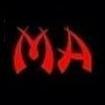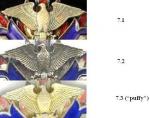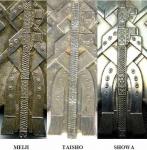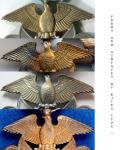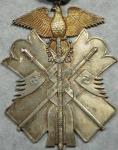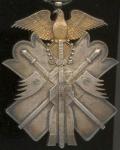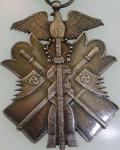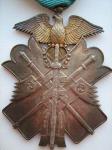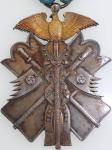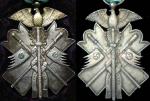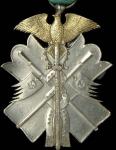-
Posts
22,214 -
Joined
-
Last visited
-
Days Won
68
Content Type
Profiles
Forums
Blogs
Gallery
Events
Store
Everything posted by JapanX
-
Types 7.1 and 7.2 usually have polished or plain reverses, type 7.3 usually has sandblasted reverse. Let`s look more closely at 7.2 and 7.3 (type 7.1 you can find above).
-
Addendum In type 7 you can observe a small variations of the form of a kite. Here you can see three main variations.
-
Hi Igor, I think its five class and its after ww II five class (I think it was made in the last quarter of the last century - around 1975-1995). Usual diameter for 5 class 46x46 mm but later specimens may be a little smaller Cheers, Nick
-
Hi Pieter and thank you very much! Very important information for me. Now it`s clear who was a mysterious "Japanese source". 30 kites in the third class and 800 in the fourth and fifth classes. It leave us with 6997 awards in two lower classes. Very unusual distribution of awards!!! And special thanks for number of awards for Boxer rebellion! Nick
-
Is it already Taisho or is it still Meiji? The only thing that should not cause any doubts in the offered classification is type 7. Quantitatively this type dominates the others by order of magnitude greater. It’s definitely Showa. Difficulties starts with types 1-6. Types 1 and 4 cannot be dated accurately. On my subjective sensations most often you can meet on the market type 1, type 2 and type 4 (in turn types 1 and 4 among these three are the more numerous types). Type 3 is rarer. Their serial arrangement in classification does not lean against any accurate information and is almost casual. Whether these four types exclusively belong to the period 1985-1905 – we have no guarantees for that! Any of this types can belong to Taisho. Yesss… The main problem as always with Taisho. Type 5 and type 6. Do they really belong exclusive to Taisho? If so, than why so much passes of these types in the market? Too much and too frequent for Taisho. I will remind to my colleagues that by the most conservative estimations (conservative from my point of view) the total number of all kites in all classes awarded during Taisho epoch is 3000. Let the biggest weight in these awardings fall on 7 class. Let even total number of awardings during Taisho be not 3000, but 30000 (this is madly overoptimistic estimation). But even then type 5 and 6 should appear in the market much less often, than we observe it today. All that can mean only one thing. Types 5 and 6 get either into Meiji epoch or into Showa epoch. Or in both epochs. Only in one thing it is possible to be more or less confident – types 1-6 belong to the period of time 1895-1932, and type 7 to the period 1932-1945. In summary it is necessary to note that the major characteristic by which it is necessary to date kites of 6 and 7 classes are apertures on a harness, instead of the form of a kite. It is especially true in a case with a beginner. After all even a skilled falerist can easily confuse the form of a kite of type 2 and type 7.
-
Only sub version 5.2 less vividly expressed this feature (but the distance is still wider).
-
Taisho badges (Type 5 and 6) or as they occasionally called, late Meiji badges, is possible to allocate in one group by two steady features. The first are outlines of a kite ("the failed" wings). The second – wider distance between harness apertures on the left tape above. Here is this place.
-
Types 1, 2 and 3 have additional common feature in the form of the wings – third feather from the top is the longest feather. At wings of types 4, 5, 6 and 7 the second feather from the top is the longest. You can see these differences at this picture.
-
Another steady sign of "old" badges (from Meiji and Taisho epoch) is the distance between the fourth aperture of a harness (considering from below) and the first tipping over of a harness (considering from below). Here it is.
-
And here that additional aperture on a harness – to be exact its presence on "old" and absence on "later" badges.
-
OLD vs. LATE Traditionally the dividing line between "old" signs (Meiji and Taisho epoch) and "later" signs (Showa epoch) in 6 and 7 class lies in the wing form of a kite and apertures of the harness. Forms of kites are shown above, and on a harness the main difference of signs on an epoch of Meiji and Taisho from signs on an epoch of Showa is presence (an epoch of Meiji or Taisho) or absence (the Showa epoch) additional aperture on a harness. This characteristics is a necessary and sufficient condition that you badge belong to epoch of Meiji or Taisho. The illustration here will be more useful than words.
-
This type has many insignificant sub variations which were created by different dies. The most significant variation is connected with surface and form of the kite’s body. Here they are.
-
Type 7 Showa Deflection in the wings disappears – they become straight. Most numerous and most unified type.
-
Type 6.2 Taisho Slightly different shape of a kite body (what we’ve got here is practically kite from Showa family – a cousin with deflection in his wings).
-
-
-
-
-
Type 5.2 Taisho Slightly different geometry of a kite body on comparison with the previous type. The very stable common feature (we will have a talk about it later) of all sub versions of type 5 less vividly expressed on this type.
-
Type 5.1 Taisho Absolutely different execution of wings (they get a deflection), and the kite itself has undergone considerable changes.
-
And another photo of type 4 from different angle (really beautiful toning of the kite and astonishing overall stamp quality). As I’ve already said – very homogeneous type.
-
Here we got two another badges of this type. I hope these photos will show in more detailed fashion the feature of “triangle wing ends”.
-
Type 4 Meiji “Triangle wing” Different geometry of a kite body and (especially) wings. Wing ends sharper (almost correct triangles). Quite unified type.


